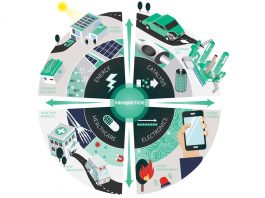Exploring the evolution of graphene from a lab-based discovery to a clinically useful tool to transform nanomedicine and health technology.
Professor Kostas Kostarelos, Chair of Nanomedicine at the Faculty of Biology, Medicine & Health of the University of Manchester and the Catalan Institute of Nanoscience and Nanotechnology in Barcelona, outlines the process of translating graphene from a lab-based discovery to a clinically useful tool.
The nanomaterial graphene is showing great promise in the medical arena. From wound-healing technology to artificial retinal vision, graphene is being used in a wide range of healthcare developments.
The National Graphene Institute, based at the University of Manchester, and the Catalan Institute of Nanoscience and Nanotechnology (ICN2) are two of the key organisations working to explore and utilise the properties of graphene and related materials for use in healthcare applications across Europe.
Professor Kostas Kostarelos leads the Nanomedicine Lab that is part of both of the above institutes. Researchers at the Nanomedicine Lab aim to develop novel, safe, and effective therapeutics based on nanoscale components and their combinations, used as either the ‘drug’ or the ‘transport system’.
Innovation News Network spoke to Professor Kostarelos to explore his work in greater detail and to find out more about graphene’s potential within the medical sector.

What are the key areas of your work currently at the National Graphene Institute and affiliated organisations?
I am leading biomedical research activities at the National Graphene Institute and the European-Commission-funded Graphene Flagship project. My work predominantly focuses on the clinical translation of graphene-based technologies, utilising the remarkable properties associated with graphene for specific applications to benefit clinical practice. To facilitate the technological development of graphene-based materials, we decided to focus on two application areas in particular.
Our main focus is the design of neural interface devices. These electrode-based implantable devices interface with the nervous system and record electrophysiological activity from the brain or the peripheral nervous system by direct contact.
One of the therapeutic concepts currently in clinical use, known as deep brain stimulation, involves the implantation of an electrode device within a specific focal structure in the brain. Electrical current is then passed through the neural tissue, alleviating patients’ motor symptoms almost immediately. The devices are intended to remain in the brain for several years and are powered by a battery implanted in the patient’s shoulder, replaced around every two years depending on usage.
The recipients of such treatment are usually patients with Parkinson’s disease who have stopped responding to pharmacological intervention. To date, clinics around the world have used electrodes, primarily made of platinum/iridium alloys, to improve the motor symptoms of thousands of patients.
A key reason why we are exploring the use of graphene as an alternative material in this area is that its 2D structure offers very low resistance and stability from passing high current, due to the seamless transportation of electrons through the graphene structures, matrixes and surfaces. They are transparent and MRI compatible, so, for clinical use, we can alleviate the shadows and obstructions in magnetic resonance imaging that metallic electric devices have.
Nanomaterials like graphene are also extremely flexible, and we are trying to take advantage of this flexibility when it comes to interfacing directly with the cavities and crevices in the brain. This presents an advantage over metals, for example, which are much more rigid.
The second area that has been developed is a little bit more conventional, from a pharmacological point of view. It involves using the suspensions of sheets of graphene – graphene oxide or functionalised forms of these 2D sheets – as platforms to deliver or present biologically active molecules. This is aimed at more traditional drug delivery, drug transport, or vaccine design applications.
When exploring graphene in clinical applications, it is important to establish a niche proposition. To translate applications within a given period of time, you must focus and invest in a specific area that you believe will allow you to get things in the clinic within the particular funding window, or the particular project which is supporting your research.
Since your time working with nanomaterials, has anything stood out to you as being particularly innovative?
I think the innovation from the material has to do with a combination of properties that it offers.
Having worked with nanomaterials for almost 25 years now, I am still surprised about how difficult it is to predict how they will interface with biological matter. Great effort is required at the early stages of exploration to understand the fundamental interactions of advanced materials with the biological milieu, and we cannot assume that a material will interact with biological matter in the same way as the previous nanomaterials we have studied.
You can witness a very improbable interaction with biological matter. We must determine how we can identify those interactions and, subsequently, how we can take advantage of the properties or the combination of these properties.
We could have a graphene sheet designed for cancer therapeutics that may not internalise on interaction with a human cancer cell. The 2D material sheet may just be sitting on the surface of the cell and interacting with its plasma membrane without internalising it. The applications intended will need to take this interaction into consideration. For example, we can take advantage of this phenomenon by passing electrical currents through or present biological moieties at the cell membrane. In that way, we can think of very interesting applications that you would not be able to achieve with other nanomaterials. That is the innovation and uniqueness that we are searching for.
In what areas is graphene showing the most promise, in terms of medical applications?
One of the main genres of medical devices under development that we see graphene being explored consistently during the last decade is sensing devices. Sensitivity in sensing is something that a lot of different laboratories and companies around the world are exploring using graphene.
This is not an easy space to operate, because you will always have to demonstrate advanced capability and function against other materials or technologies. My opinion is that it is always much more compelling when introducing a new material, especially in the medical field, to offer a unique function that no other device or material offers. However, it is understandable that established technologies offer the attraction of established markets.
If we can design a device that is going to be able to perform a function that is way above that of currently used materials or technologies, we then have a competitive advantage and a unique proposition. This is why, in the neural interface space, we believe we have more advantages because we think that the metal interfaces, like platinum/iridium interfaces, have very clear limitations associated with their inherent capabilities.
Then there are spaces like cancer, where there are many different strategies. We are not only talking about cytotoxic agents, but also the presentation of immune activation molecules, and vaccination, etc. There is certainly a lot of activity and possibilities, but it is still uncertain yet as to the exact application those new 2D sheets can offer the compelling competitive advantage over existing systems.

© iStock/RED_SPY
How is nanomedicine progressing and what is its future potential for medical innovation? Do you think more investment and resources are required?
There is no question that everybody wants more investment to facilitate progress, but that is the case for most technologies in an exploratory or early adoption phase.
Obviously, we need investment at this early adoption stage when the risk is high. If you are proposing a new technology or a new material in a particular biomedical application, you will have people that will enthusiastically adopt it, but you will have an equal number of critics or people that will resist adoption. This could be because they are not convinced, or because they have a vested interest in the technology that preceded what you are proposing. You therefore need investment to sustain the criticism. In reference to my earlier point, it is therefore advantageous to propose a function that is not achievable with existing technology. But in any case, you will need sustained, long-term investment to support development from the laboratory or research facility to industrial-scale manufacturing and production.
I think the most difficult aspect, however, stretches beyond the financial element and is about a change in culture, and facilitating the framework by which you can translate advanced technology safely and reliably.
As a non-graphene related example, we can look at mRNA vaccines. Many people believe that mRNA is a new technology, but this is not correct. Nucleic acid delivery and therapeutics (including mRNA) have been developed for many years, with hundreds of laboratories and many companies that had consistently attempted and, most commonly, failed to clinically translate their technologies, by focusing on complex diseases like cancer. This was due to the market drivers at the time. It is vital for a market to be able to sustain the investment needed for new technology. In the case of mRNA treatment for complex diseases, it did not prove to be initially successful and required more investment to fund further investigation. However, without results, investors were unwilling to further commit financially. This left companies, such as Moderna, on the brink of existence for several years. The COVID-19 pandemic then unexpectedly created a vast market for mRNA technology, with enormous opportunity for investment. The technology was adopted early on in the pandemic and proved effective as a vaccine against serious illness from infection. This, combined with a market that was able to sustain development, is now considered a great success, that I believe will have a tremendous impact in the wider adoption of nucleic acid therapeutics.
We must then consider what would have happened under normal circumstances and without a booming market brought about by the pandemic. We should also look at the systems and frameworks that we have in place to adopt new technologies for the benefit of patients and clinical practice.
In short, it is not just about money, but it is about how primed the entire ecosystem is to sustain the required level of development in graphene innovation. It is about sustainability in time. You should not be expecting a new material that has captured, in the case of graphene, a Nobel Prize and major scientific attention to translate into a medical device or therapeutic application that will make a difference within five to ten years. Some people may expect that graphene is going to change the world. This could be the case in some areas, but in many years from now. Once these scientific discoveries have taken place, it is not guaranteed that adoption and a shift in practice will take place, and certainly not at the same pace as the discoveries in the laboratories.
Professor Kostas Kostarelos
Chair of Nanomedicine at the Faculty of Biology,
Medicine & Health
University of Manchester
Catalan Institute of Nanoscience and Nanotechnology (ICN2)
www.graphene.manchester.ac.uk/ngi/about
https://icn2.cat/en/
Please note, this article will also appear in the ninth edition of our quarterly publication.









